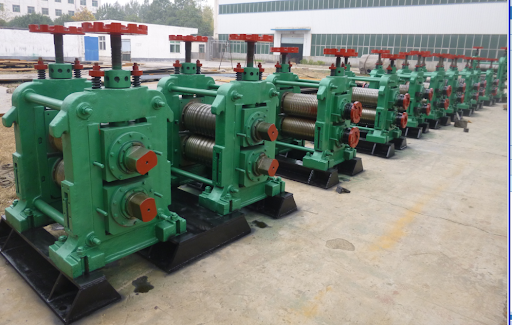rolling mills | Metal Processing Machinery
What is the use of rolling mill?

A rolling mill, also known as a steel mill, is a device that realizes the metal rolling process. It mainly uses two rotating rollers to extrude and deform metal materials to obtain materials of various shapes and sizes.
Rolling is the most important production method in metal pressure processing, and rolling mills are also the main pressure processing equipment. The uses of rolling mills include:
1. Changing the shape and size of metal materials:
Raw materials such as steel billets and aluminum ingots can be rolled into various plates, pipes, profiles (such as angle steel, channel steel, etc.) and wires, etc., to meet the requirements of different industrial fields for the shape and size of metal materials.
2. Improving the performance of metal materials:
Through pressure processing during the rolling process, the grain structure inside the metal is refined, thereby improving the mechanical properties of the material such as strength, hardness, and toughness.
3. Improving production efficiency:
It can achieve continuous and large-scale production, and has higher production efficiency than other processing methods.
4. Ensuring the consistency of product quality:
Rolling under precisely controlled conditions helps to ensure the dimensional accuracy, surface quality and performance consistency of the product.
5. Save materials:
Raw materials can be reasonably distributed and processed according to needs to reduce material waste. In short, rolling mills play a vital role in the field of metal processing and provide high-quality metal materials for many industries. What are the advantages of rolling mills?
The rolling mill has the following advantages:
1. Efficient production:
It can achieve continuous and high-speed rolling, greatly improve production efficiency, and is suitable for large-scale industrial production.
2. High-precision forming:
The size and shape of the rolled piece can be accurately controlled to ensure the dimensional accuracy and shape accuracy of the product.
3. Improve material properties:
Through plastic deformation during rolling, the metal grains are refined and the internal structure of the metal is improved, thereby improving the mechanical and physical properties of the material.
4. High material utilization rate:
It can effectively reduce processing allowances, reduce material loss, and improve the utilization rate of raw materials.
5. Can produce a variety of products:
It can produce various types of plates, pipes, profiles and wires, etc. to meet the needs of different industries and fields.
6. High degree of automation:
Modern rolling mills are usually equipped with advanced automatic control systems to facilitate operation and monitoring of the production process, reduce manual intervention, and reduce labor intensity.
7. Cost-effectiveness:
In large-scale production, the production cost per unit product is relatively low.
8. Optimize material performance distribution:
Different performance distribution can be achieved in different parts according to the product’s usage requirements.

